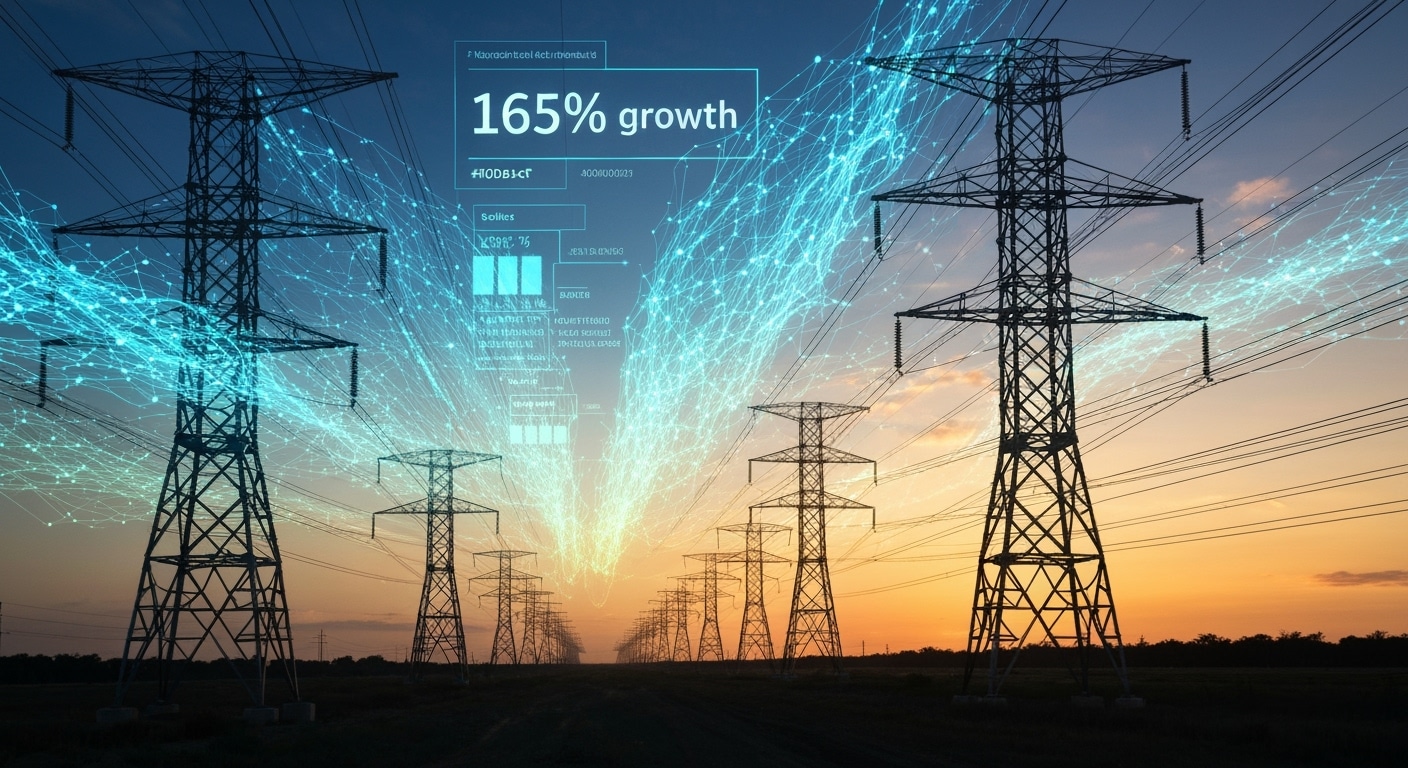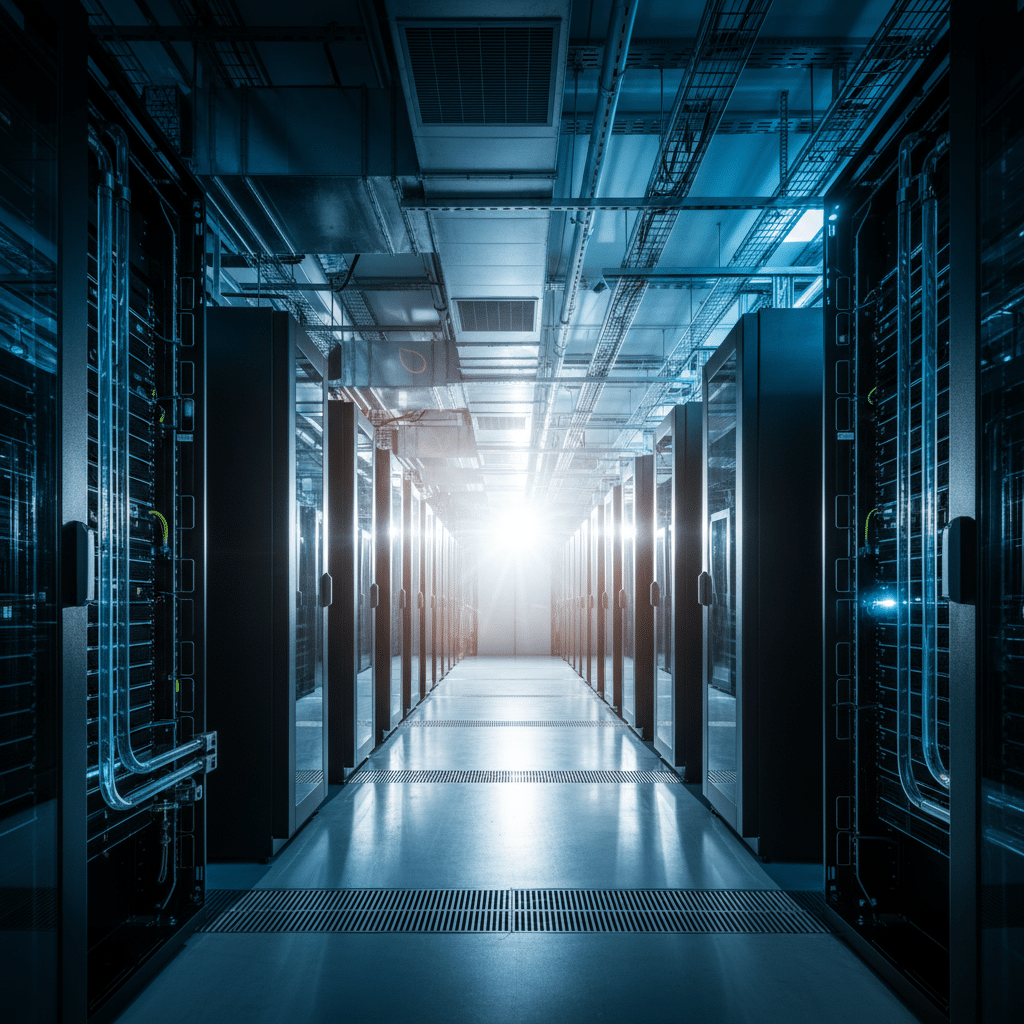Summary
The digital infrastructure landscape is experiencing unprecedented transformation as AI workloads drive power demands up 165% by 2030.
- Power constraints in traditional markets are forcing geographic diversification and renewable energy integration
- Edge computing expansion requires distributed infrastructure capable of ultra-low latency processing
- Quantum computing infrastructure preparation becomes essential for competitive positioning
- Advanced cooling technologies transition from optional to mandatory for high-density environments
Organizations that proactively adapt their digital infrastructure strategies now will dominate the next decade of technological advancement.
The year 2026 represents a pivotal moment for digital infrastructure development. According to Goldman Sachs Research, global data center power demand will surge by 165% by 2030 compared to 2023 levels, fundamentally reshaping how organizations approach infrastructure planning. This isn’t just about building more data centers—it’s about completely rethinking the foundation of our digital economy.
The convergence of artificial intelligence, edge computing, quantum technologies, and sustainability mandates is creating infrastructure requirements that would have seemed impossible just five years ago. Traditional approaches to site selection, power procurement, and facility design are proving inadequate for the scale and complexity of emerging digital infrastructure trends.
The organizations that recognize these shifts early and adapt their strategies accordingly will capture the majority of growth opportunities in the coming decade. Those that continue operating with legacy infrastructure thinking will find themselves constrained by power limitations, cooling challenges, and technological obsolescence that threatens their competitive position.
Why Do Digital Infrastructure Trends Matter More Than Ever in 2026?
Digital infrastructure has evolved from a supporting IT function to the primary competitive differentiator for modern enterprises. The Department of Energy reports that U.S. data centers consumed 176 terawatt-hours of electricity in 2023, representing 4.4% of total national consumption—a figure projected to reach up to 12% by 2028.
This massive growth is being driven by computational workloads that didn’t exist at scale just two years ago. AI training requires continuous, high-density power delivery that traditional data centers simply weren’t designed to handle. Machine learning inference demands ultra-low latency networking that pushes the boundaries of current connectivity infrastructure. Edge computing applications require distributed processing capabilities that challenge conventional centralized models.
The Infrastructure Performance Gap
The gap between existing infrastructure capabilities and emerging requirements has created unprecedented market dynamics. CBRE’s Global Data Center Trends 2025 reports that data center occupancy rates increased from 85% in 2023 to over 95% by late 2025, with wait times for power connections extending up to five years in premium markets like Northern Virginia and Silicon Valley.
This capacity crunch is forcing organizations to completely reconsider their approach to infrastructure planning. Companies that historically focused on location convenience or cost optimization are now prioritizing power availability and sustainability above all other factors. The ability to secure reliable, scalable power has become the determining factor for digital infrastructure success.
Geographic Redistribution of Digital Infrastructure
Traditional data center hubs are reaching their capacity limits, creating opportunities in secondary markets with abundant renewable energy resources. States like Ohio, Indiana, and Wyoming are experiencing unprecedented data center investment as hyperscalers follow available power rather than established technology clusters.
This geographic redistribution isn’t temporary—it represents a fundamental shift toward power-first infrastructure development that will define the next decade of digital infrastructure solutions.

8 Critical Digital Infrastructure Trends Reshaping 2026
How Will AI Workloads Transform Power Requirements?
Artificial intelligence represents the single most disruptive force in modern digital infrastructure trends. Unlike traditional computing workloads that experience predictable demand cycles, AI training and inference require sustained, high-density power delivery that challenges every aspect of conventional data center design.
Data Center Dynamics reports that dedicated AI data centers are expected to consume between 100 and 300 TWh by 2026, requiring power densities that can exceed 150 kW per rack—nearly ten times traditional levels. This isn’t just about adding more power connections; it demands completely reimagined electrical distribution, cooling systems, and backup power strategies.
The computational intensity of modern AI models continues to increase exponentially. Large language models require distributed training across thousands of GPUs, each consuming significantly more power than traditional CPUs. Real-time AI inference applications demand consistent power delivery with minimal fluctuation to maintain model accuracy and response times.
Organizations preparing for AI deployment must consider power requirements that extend far beyond their current capacity. This includes not just the compute infrastructure itself, but the supporting systems required for cooling, networking, and redundancy that enable reliable AI operations at scale.
Why Are Power Constraints Creating Infrastructure Innovation?
Power availability has emerged as the primary bottleneck for digital infrastructure development worldwide. Goldman Sachs estimates that approximately $720 billion in grid upgrades will be required through 2030 to meet projected data center demand—investments that require years to permit and construct.
This constraint is driving remarkable innovation in power procurement and delivery strategies. Organizations are moving beyond traditional utility relationships to develop integrated approaches that combine renewable energy generation, storage systems, and demand management technologies. Advanced cooling system integration has become essential for maximizing power efficiency in high-density environments.
The most successful infrastructure developments in 2026 will be those that treat power as the primary design constraint from the beginning. This means identifying sites based on available renewable energy resources, designing facilities for maximum power efficiency, and implementing management systems that optimize consumption in real-time.
What Role Will Edge Computing Play in Infrastructure Distribution?
Edge computing is transitioning from an interesting concept to an operational necessity for applications requiring ultra-low latency processing. STL Partners predicts there will be just under 1,200 network edge data centers by 2026, representing a dramatic expansion of distributed computing infrastructure.
This growth is being driven by applications that simply cannot function with the latency involved in centralized processing. Autonomous vehicles require real-time decision-making that demands local compute resources. Industrial automation systems need immediate response capabilities for safety and efficiency. Augmented reality applications require processing latencies measured in single milliseconds.
Edge infrastructure presents unique challenges compared to traditional centralized data centers. These facilities must operate reliably in diverse environmental conditions while maintaining the same security and connectivity standards as hyperscale facilities. They require modular designs that can be deployed rapidly and scaled incrementally based on local demand patterns.
The organizations that develop effective edge infrastructure strategies will capture significant advantages in emerging markets where low-latency processing becomes a competitive requirement. This includes not just technology companies, but manufacturing, healthcare, transportation, and retail organizations deploying IoT and automation at scale.

How Is Quantum Computing Infrastructure Becoming Essential?
Quantum computing infrastructure preparation represents one of the most forward-looking digital infrastructure trends for 2026. While practical quantum computers remain primarily in research and development phases, the infrastructure requirements for quantum-ready facilities are becoming clear enough to influence current planning decisions.
McKinsey’s Quantum Technology Monitor 2025 reports that the quantum communication market reached $1.2 billion in 2024 and could grow to $10.5-14.9 billion by 2035, indicating significant infrastructure investments ahead.
Quantum computing requires entirely different infrastructure considerations compared to traditional computing. These systems need cryogenic cooling capabilities to maintain quantum states, specialized shielding to prevent electromagnetic interference, and security infrastructures designed for quantum key distribution.
Organizations that begin preparing quantum-ready infrastructure now will position themselves advantageously as quantum technologies transition from laboratory demonstrations to commercial applications. This preparation includes evaluating sites for quantum facility requirements, planning electrical and cooling systems that can support cryogenic equipment, and designing network architectures compatible with quantum communication protocols.
What Advanced Cooling Technologies Are Becoming Standard?
The transition from air cooling to liquid cooling systems represents one of the most significant infrastructure changes happening in 2026. JLL’s 2025 Data Center Outlook reports that liquid cooling is becoming essential for high-density racks, with new construction defaulting to liquid cooling infrastructure rather than treating it as an upgrade option.
Current approaches typically employ hybrid strategies combining liquid and air cooling systems, using technologies like rear door heat exchangers and direct-to-chip cooling systems. However, as GPU power densities continue increasing to extreme levels, immersion cooling technologies are becoming necessary for the most demanding AI workloads.
The cooling transformation extends beyond just the technology itself. Liquid cooling systems require different infrastructure planning, including specialized plumbing, leak detection systems, and maintenance procedures. They also offer opportunities for heat recovery and reuse that can improve overall facility efficiency and reduce environmental impact.
Organizations planning new data center construction must now design for liquid cooling from the beginning, as retrofitting air-cooled facilities proves both expensive and technically challenging. This represents a fundamental shift in how cooling systems are integrated into overall facility design and operations.
How Are Site Selection Criteria Evolving?
Traditional data center site selection based on proximity to metropolitan areas or existing technology clusters is giving way to power-first strategies that prioritize energy availability above conventional location factors. This shift reflects the reality that power has become the primary constraint for digital infrastructure development.
Modern site selection considers renewable energy resource quality alongside traditional infrastructure factors. Sites with excellent solar irradiance, consistent wind patterns, or access to geothermal resources enable higher capacity factors and better economic returns from renewable installations. Geographic diversification reduces weather-related risks while accessing different renewable resources across multiple regions.
The most valuable sites now feature access to abundant renewable energy resources, streamlined regulatory environments for faster permitting, strategic positioning near transmission corridors with available capacity, and proximity to qualified technical workforces experienced in energy and infrastructure development.
Choosing the right digital infrastructure provider requires understanding how power-first site selection strategies align with long-term business objectives and sustainability commitments.
What Connectivity Infrastructure Changes Are Required?
Digital infrastructure trends in 2026 require networking capabilities that extend far beyond traditional internet connectivity. Modern applications demand specialized private networks, direct cloud connections, and software-defined networking capabilities that enable flexible and efficient data transmission across distributed infrastructure.
5G integration is becoming essential for edge computing applications, requiring data centers to support both traditional fiber connectivity and wireless infrastructure. This includes considerations for small cell deployments, edge caching capabilities, and integration with telecommunications provider networks.
The networking requirements for AI workloads present particular challenges. Large-scale AI training requires high-bandwidth, low-latency interconnects between distributed compute resources. Real-time AI inference applications demand consistent network performance with minimal jitter or packet loss that could impact model accuracy.
Organizations developing networking strategies for 2026 must consider how their connectivity infrastructure will support not just current applications, but emerging technologies like quantum communication, holographic computing, and advanced IoT deployments that will define the next generation of digital services.
Why Is Sustainability Integration Becoming Mandatory?
Sustainability has transitioned from an optional consideration to a mandatory component of digital infrastructure planning. Corporate sustainability commitments from major technology companies are creating downstream pressure on infrastructure providers to demonstrate measurable environmental performance alongside traditional reliability and performance metrics.
Data center sustainability and ESG considerations now influence every aspect of infrastructure development, from site selection and energy procurement to cooling system design and waste heat recovery strategies. Organizations that fail to integrate sustainability into their infrastructure planning risk losing access to preferred partnerships and customer relationships.
The regulatory environment continues to evolve toward mandatory sustainability reporting and performance standards. The European Union now requires data centers over 500 kW to report renewable energy consumption, energy efficiency metrics, and waste heat utilization. Similar requirements are emerging across U.S. states, with California leading comprehensive energy efficiency standards for digital infrastructure.
Advanced sustainability strategies go beyond basic renewable energy procurement to include considerations like carbon lifecycle assessments, circular economy principles for equipment disposal, and integration with local energy grids to provide demand response and grid stabilization services.
What Are the Digital Infrastructure Investment Priorities for 2026?
As digital infrastructure demands reach unprecedented levels, organizations face critical decisions about where to allocate capital and resources for maximum competitive advantage. The convergence of AI workloads, power constraints, and sustainability mandates requires strategic investment approaches that balance immediate operational needs with long-term technological evolution.
Understanding these investment priorities becomes essential for securing infrastructure capacity in an increasingly constrained market while preparing for emerging technologies that will define the next decade of digital growth.
Critical Infrastructure Components
Organizations developing digital infrastructure strategies for 2026 should prioritize investments in several critical areas that will determine long-term competitive positioning:
Power Infrastructure Excellence: This includes renewable energy integration capabilities, advanced storage systems for grid independence, and sophisticated load management technologies that optimize consumption patterns in real-time.
Cooling System Innovation: Advanced liquid cooling capabilities, heat recovery systems for improved efficiency, and modular cooling designs that can scale with computational demands.
Network Infrastructure Flexibility: High-bandwidth fiber connectivity, 5G integration capabilities, and software-defined networking systems that enable dynamic resource allocation across distributed infrastructure.
Quantum Readiness Preparation: Specialized cooling capabilities for cryogenic systems, electromagnetic shielding for quantum state preservation, and security infrastructure designed for quantum communication protocols.
Strategic Planning Considerations
Successful digital infrastructure development in 2026 requires long-term strategic thinking that balances current needs with future technological requirements. Creating a scalable digital infrastructure plan involves understanding how today’s investments will support tomorrow’s applications.
The most effective strategies employ modular development approaches that allow infrastructure to scale incrementally with business growth. This includes standardized building blocks that can be replicated across multiple sites, unified management systems that enable coordinated operations, and financial models that optimize capital deployment across extended timeframes.
Organizations must also consider how their infrastructure strategies align with broader industry trends toward edge computing, artificial intelligence, and sustainability. The decisions made today about power procurement, cooling technologies, and site selection will determine competitive positioning for the next decade.

How Do Digital Infrastructure Trends Vary by Region?
Digital infrastructure development follows distinct patterns across global markets, shaped by regulatory environments, available resources, and regional technology priorities. While power constraints and AI demand growth represent universal challenges, each region’s approach to solving these problems reflects local conditions, policy frameworks, and market maturity levels.
North American Market Dynamics
North America continues to lead global data center development, but regional dynamics are shifting dramatically due to power constraints in traditional markets. Northern Virginia remains the world’s largest data center market but faces significant utility connection delays that are forcing development into secondary markets.
Texas has emerged as a major growth region due to abundant renewable energy resources and supportive regulatory environments. The combination of wind and solar resources, coupled with the state’s independent grid operator and business-friendly policies, creates attractive conditions for large-scale infrastructure development.
The Pacific Northwest continues to attract development due to abundant hydroelectric power, though permitting challenges and environmental regulations create development complexities. California’s strict environmental standards are driving some development to adjacent states while simultaneously spurring innovation in efficiency and sustainability technologies.
European Infrastructure Evolution
European digital infrastructure trends for 2026 are being shaped by aggressive sustainability mandates and data sovereignty requirements. The EU’s comprehensive regulations on data center energy reporting and efficiency standards are driving innovation in renewable energy integration and operational optimization.
Power availability challenges are emerging across major European markets, with countries like Ireland and the Netherlands implementing restrictions on new data center development due to grid capacity constraints. This is creating opportunities in secondary markets with available renewable energy resources and supportive regulatory frameworks.
Data sovereignty requirements continue to influence infrastructure planning, with organizations required to maintain data processing capabilities within specific geographic boundaries. This is driving demand for distributed infrastructure that can support localized processing while maintaining connectivity to global networks.
Asia-Pacific Growth Patterns
The Asia-Pacific region continues to experience rapid digital infrastructure growth, driven by expanding internet penetration, mobile adoption, and digital transformation initiatives across emerging economies. However, power availability and environmental concerns are creating similar constraints to those experienced in developed markets.
Singapore’s moratorium on new data center development has created opportunities in secondary markets across Southeast Asia. Countries like Malaysia, Thailand, and Vietnam are developing specialized economic zones for digital infrastructure with streamlined permitting and power allocation processes.
China’s focus on domestic technology development and data sovereignty creates unique requirements for infrastructure operating within its borders. The country’s aggressive renewable energy targets are driving innovation in grid integration and energy storage technologies that influence global best practices.
How Should Organizations Prepare for Digital Infrastructure Transformation?
Assessment and Planning Framework
Organizations preparing for digital infrastructure transformation should begin with comprehensive assessments of their current capabilities and future requirements. This includes evaluating existing power capacity and efficiency, analyzing cooling system adequacy for high-density workloads, assessing network infrastructure scalability, and reviewing sustainability performance against emerging standards.
The planning process should consider both immediate needs and long-term strategic objectives. Why your digital infrastructure plan needs to include renewable energy explores how sustainability integration creates both operational advantages and competitive positioning benefits.
Effective planning requires understanding how different infrastructure components interact and influence each other. Power system design affects cooling requirements, which influence facility layout, which impacts networking architecture. These interdependencies require integrated planning approaches that consider all infrastructure elements simultaneously.
Implementation Strategies
Successful digital infrastructure transformation requires careful phasing and risk management. Organizations should prioritize investments that provide immediate operational benefits while building toward long-term strategic capabilities.
Modular implementation approaches allow organizations to test and refine new technologies before full-scale deployment. This includes pilot projects for advanced cooling technologies, renewable energy integration demonstrations, and edge computing prototypes that inform broader infrastructure strategies.
Partnership strategies become increasingly important as infrastructure requirements become more complex and specialized. Organizations may benefit from collaborating with infrastructure developers, energy providers, and technology vendors that offer integrated solutions rather than attempting to manage all aspects of transformation internally.
Risk Management and Contingency Planning
Digital infrastructure transformation involves significant risks that require careful management and contingency planning. Power availability risks can delay projects for years, making backup strategies essential for organizations with time-sensitive requirements.
Technology risks require balanced approaches that adopt proven innovations while avoiding unproven technologies that could create operational challenges. This includes evaluating cooling technologies, renewable energy systems, and networking solutions based on demonstrated performance rather than theoretical capabilities.
Financial risks require careful evaluation of infrastructure investments against uncertain demand projections and changing technology requirements. Organizations should develop financial models that account for various growth scenarios and technology evolution paths.
What Are the Industry-Specific Digital Infrastructure Considerations?
Financial Services Infrastructure Requirements
Financial services organizations face unique digital infrastructure challenges due to regulatory requirements, security mandates, and low-latency trading applications. These organizations require infrastructure that combines maximum reliability with strict compliance capabilities.
High-frequency trading applications demand ultra-low latency networking that pushes the boundaries of current connectivity technologies. Regulatory requirements for data residency and operational resilience create specific geographic and redundancy requirements that influence infrastructure planning.
The financial services industry’s adoption of artificial intelligence for fraud detection, risk management, and algorithmic trading creates power and cooling requirements similar to those faced by technology companies, but with additional compliance and security considerations.
Healthcare Digital Infrastructure Needs
Healthcare organizations are experiencing rapid digital transformation driven by telemedicine, electronic health records, and AI-powered diagnostic systems. These applications require infrastructure that combines high availability with strict privacy and security controls.
Medical imaging and genomic analysis applications require significant computational resources and storage capacity, creating infrastructure demands similar to those in research and scientific computing. Real-time monitoring and emergency response systems demand ultra-reliable connectivity and power systems.
Regulatory requirements like HIPAA create specific security and privacy requirements that influence infrastructure design, including data encryption, access controls, and audit capabilities that must be integrated into all infrastructure components.
Manufacturing and Industrial IoT Requirements
Manufacturing organizations are deploying extensive IoT networks and automation systems that require distributed edge computing capabilities. These applications demand real-time processing with minimal latency for safety and efficiency reasons.
Industrial environments present unique infrastructure challenges including harsh operating conditions, electromagnetic interference, and integration with legacy systems. Edge computing infrastructure must operate reliably in factory environments while maintaining connectivity to centralized systems.
The integration of artificial intelligence into manufacturing processes creates hybrid infrastructure requirements that combine edge processing for real-time control with centralized compute resources for training and optimization of AI models.
How Can Organizations Build Future-Ready Digital Infrastructure?
The digital infrastructure trends reshaping 2026 represent both unprecedented challenges and extraordinary opportunities for organizations willing to adapt their strategies to emerging realities. The convergence of AI workloads, power constraints, edge computing requirements, and sustainability mandates is creating infrastructure demands that require completely new approaches to planning, development, and operations.
Organizations that recognize these trends early and begin adapting their infrastructure strategies now will capture the majority of competitive advantages available in the next decade. Those that continue operating with legacy approaches will find themselves constrained by power limitations, cooling challenges, and technological obsolescence that threatens their long-term viability.
The most successful infrastructure strategies for 2026 will be those that treat power availability as the primary design constraint, embrace advanced cooling technologies as standard requirements, integrate sustainability performance as a competitive differentiator, and prepare for emerging technologies like quantum computing before they become mainstream requirements.
Ready to Transform Your Digital Infrastructure Strategy?
The infrastructure decisions you make today will determine your organization’s competitive position for the next decade. As digital infrastructure trends continue accelerating toward unprecedented complexity and scale, having the right strategic partner becomes essential for success.
174 Power Global specializes in developing comprehensive energy solutions that address the full spectrum of modern digital infrastructure challenges. From gigawatt-scale renewable energy development to quantum-ready facility planning, we provide the integrated expertise required to navigate the transformation ahead. Contact our team to discuss how we can help build your organization’s infrastructure for the opportunities ahead.
Frequently Asked Questions
What are the biggest digital infrastructure trends affecting data centers in 2026? The most significant trends include AI-driven power demand increases, power constraints forcing geographic redistribution, edge computing expansion requiring distributed infrastructure, quantum computing preparation, advanced cooling technology adoption, power-first site selection strategies, enhanced connectivity requirements, and mandatory sustainability integration.
How much will data center power consumption increase by 2030? Goldman Sachs Research projects global data center power demand will increase by 165% by 2030 compared to 2023 levels, growing from approximately 55 GW currently to 122 GW by the end of the decade, driven primarily by AI workloads.
Why are traditional data center locations becoming less attractive? Traditional markets like Northern Virginia and Silicon Valley are experiencing severe power constraints with utility connection wait times extending up to seven years. This is forcing organizations to consider secondary markets with abundant renewable energy resources and available power infrastructure.
What cooling technologies are becoming essential for modern data centers? Liquid cooling is transitioning from optional to mandatory for high-density AI workloads. New construction now defaults to liquid cooling infrastructure, with hybrid approaches combining liquid and air cooling systems. Immersion cooling is becoming necessary for the highest-density workloads that exceed traditional cooling capabilities.
How should organizations prepare for quantum computing infrastructure requirements? Quantum readiness preparation includes evaluating sites for cryogenic cooling capabilities, planning electromagnetic shielding for quantum state preservation, designing security infrastructure for quantum communication protocols, and considering specialized power and environmental requirements that differ significantly from traditional computing infrastructure.
What role does sustainability play in digital infrastructure planning? Sustainability has become mandatory rather than optional, driven by corporate commitments, regulatory requirements, and customer expectations. Organizations must integrate renewable energy procurement, energy efficiency optimization, and environmental impact reduction into all infrastructure planning decisions.




